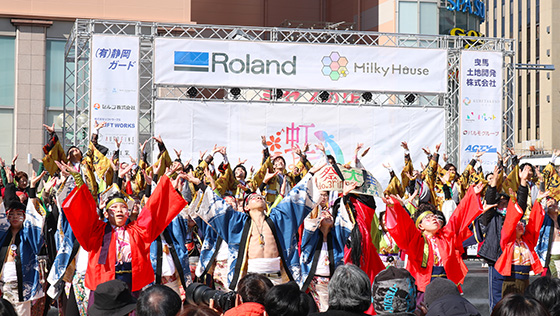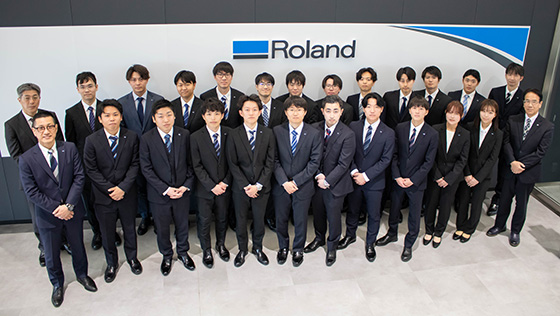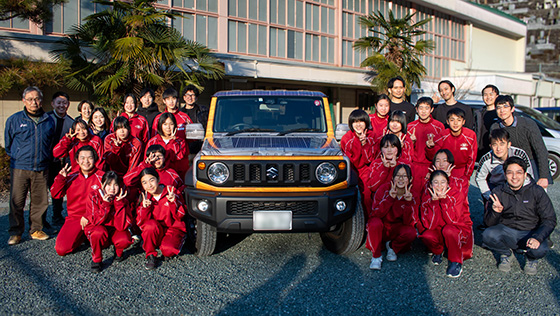Together with Suppliers
To supply customers with high-quality products while maintaining a low environmental impact, forging partnerships with suppliers that constitute the supply chain is essential. Based on the spirit of mutual trust and mutual growth, Roland DG is committed to developing a sustainable supply chain by focusing on open and fair transactions, reasonable costs and excellent quality, and procurement methods that have a low environmental impact.
Compliance with Environmental Regulations
As a global corporation, Roland DG complies with the requirements set forth by the European RoHS Directive and the REACH regulation, and keeps up-to-date with the ongoing changes being made to various applicable laws and statutes. REACH is a particularly strict set of regulations governing chemical substances, and as it requires thorough management of information on chemical substances contained in materials procured through the supply chain, Roland DG is working on enhancing collaborative efforts of the overall supply chain. Efforts are currently being made to meet GHS,* with full compliance attained in more than ten countries including Japan—which established the earliest deadline for compliance—and China, Korea and Europe. Developments are also gradually being made in other regions to meet requirements. Roland DG will continue to further strengthen relationships with suppliers, overseas subsidiaries and distributors to enhance collaborative efforts throughout the supply chain with the aim of complying with globally standard environmental regulations.
* GHS (Globally Harmonized System of Classification and Labelling of Chemicals): a system of international standards for hazardous material classification and labeling schemes (labels and SDS) relating to chemicals requiring hazard (toxic) classification.
Green Procurement
Roland DG has established green procurement guidelines and, with the understanding and cooperation of suppliers, is expanding efforts to reduce hazardous chemical substances contained in parts and materials during the procurement stage. The prohibited, restricted and controlled substances defined in the guidelines are being further tightened to comply with REACH regulations and other chemical substances regulations in each country.
Verifying Sustainability with Suppliers
Before beginning any transactions, suppliers are screened by applying the "Supplier Acceptance Guide." In addition to verifying the financial condition of suppliers, this guide also serves to assess the physical condition of managers, whether any successors have been appointed and their level of training, as well as any potential earthquake and flood risks of business sites, to ensure a sustainable level of mutual cooperation and growth is viable.
Diversifying Parts Procurement Sources and Risk Hedging
Roland DG is headquartered in Hamamatsu City in Shizuoka Prefecture—one of the manufacturing industry's leading hubs in Japan—and ever since its establishment, has maintained close communication with local suppliers based in Hamamatsu with the aim of achieving mutual growth. In recent years, Roland DG has been expanding its network of suppliers beyond Japan and into the Asia region, with Roland Digital Group (Thailand) Ltd. established in 2011 as the first overseas manufacturing base. Extending the geographic scope of suppliers and increasing the number of production sites serve as part of efforts to develop a business continuity plan (BCP) to fall back on in case a major natural disaster strikes. In addition to manufacturing, Roland Digital Group (Thailand) Ltd. has also been expanding its scope of procurement by increasing its local-content rate, and from 2015 almost all parts for inkjet printers, with the exception of print heads, were sourced locally. This mutually complementary relationship will continue to be developed moving forward as part of risk hedging efforts.
More Paperless Operations
Roland DG rolled out a Web-EDI system from 2001 in a move to paperless operations for parts orders. A 100% paperless rate of operations have been achieved for product drawings by making shared 3D CAD design data available, which helps to save resources and increase production efficiency in machining and manufacturing processes of steel and metal parts.




